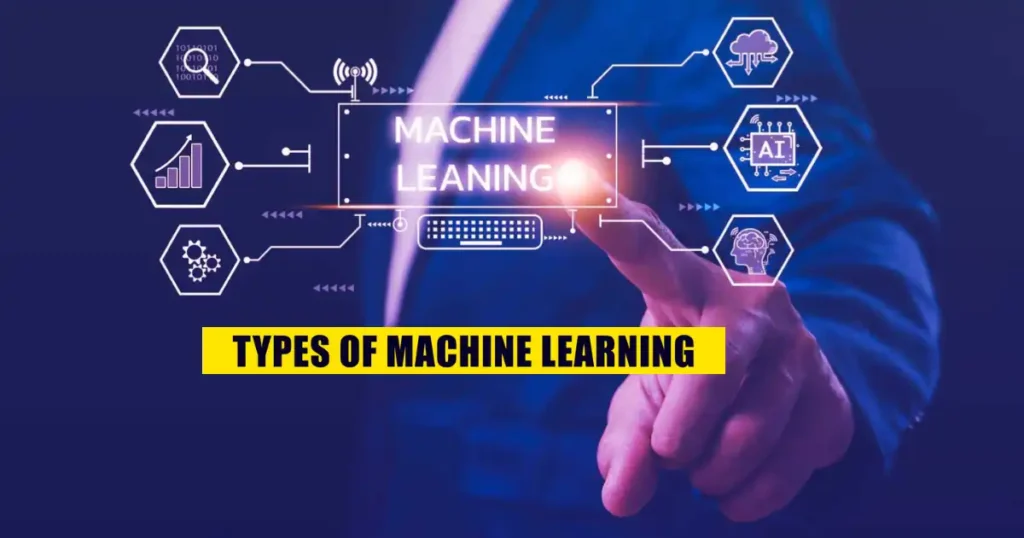These 4 Types of Machine learning (ML) has transformed how we interact with data, revolutionizing industries and opening doors to innovative solutions. From product recommendations to autonomous driving, ML shapes our technology landscape by enabling computers to learn from data and improve over time.
In this guide, we’ll delve into the four primary types of machine learning (Supervised Learning, Unsupervised Learning, Semi-Supervised Learning, and Reinforcement Learning) each serving unique purposes for different types of problems.
By understanding these ML types, we can better comprehend how they contribute to solving real-world challenges.
In-Depth Introduction to Machine Learning
Machine learning is a branch of artificial intelligence (AI) that empowers systems to learn from data patterns and make predictions or decisions. In contrast to traditional programming, where a developer explicitly codes each instruction, ML algorithms automatically improve by identifying trends in data. This adaptability makes ML a powerful tool for data-driven decision-making, where high-quality data, rather than hard-coded instructions, informs predictions.
In a world driven by big data, the significance of machine learning is undeniable. However, understanding which ML approach is best suited for a problem is essential, as each type of ML model processes data differently.
Here’s an overview of the four primary types of machine learning, each designed to tackle specific challenges in a data-rich environment.
Detailed Overview of the Four Types of Machine Learning
1. Supervised Learning
Supervised learning is a method where a model is trained on labeled data, meaning each input has a corresponding output label. The model’s objective is to learn the mapping between inputs and outputs so it can make predictions on new, unseen data. For instance, if training a model to predict housing prices, the input data might include square footage, location, and other features, while the output label is the house price.
Common Algorithms
-
Decision Trees:
This algorithm makes predictions by splitting data into branches based on specific features, forming a tree-like structure.
-
Linear Regression:
Ideal for predicting continuous outcomes, such as house prices or stock values, using a linear relationship between variables.
-
Neural Networks:
Inspired by the human brain, neural networks excel at recognizing complex patterns, especially in tasks like image and speech recognition.
Real-World Applications
Supervised learning is widely used in areas where labeled data is abundant, and accurate predictions are essential:
-
Stock Price Prediction:
Analyzing historical stock data to predict future trends.
-
Medical Diagnosis:
Assisting doctors by predicting patient diagnoses based on medical records.
-
Image Recognition:
Identifying and classifying objects within images, useful in social media, retail, and security applications.
Challenges and Limitations
Supervised learning requires a large amount of labeled data, which can be costly and time-consuming to obtain. Additionally, the model’s performance is highly dependent on the quality and diversity of the labeled data; biased or unrepresentative datasets can lead to inaccurate predictions.
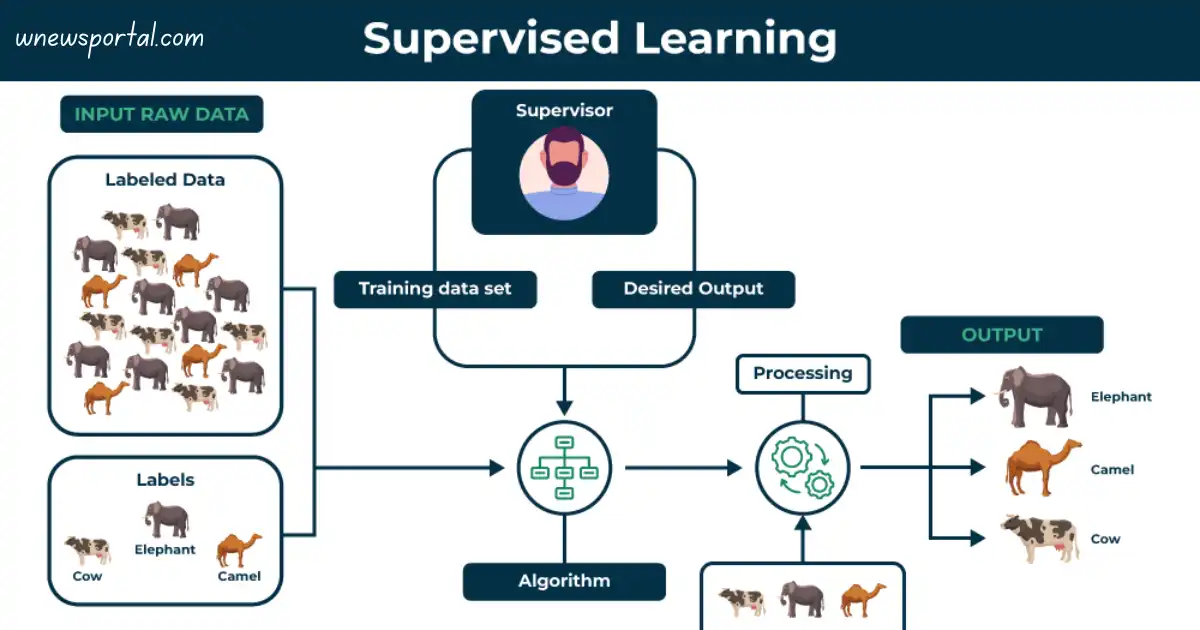
2. Unsupervised Learning
Unsupervised learning works on unlabeled data, meaning the model doesn’t have predefined outputs and instead seeks to uncover patterns within the data itself. This approach is valuable for exploratory data analysis and revealing hidden structures that may not be immediately apparent.
Popular Algorithms
-
K-Means Clustering:
Groups data points into clusters based on similarity, often used in customer segmentation.
-
Hierarchical Clustering:
Builds a tree of clusters, which helps visualize relationships between data points.
-
Principal Component Analysis (PCA):
Reduces data dimensions, revealing influential features and simplifying complex datasets.
Applications
Unsupervised learning is ideal for applications where labels are unavailable or unfeasible:
-
Anomaly Detection:
Identifying unusual data points, essential in fraud detection and cybersecurity.
-
Customer Segmentation:
Grouping customers based on purchase behaviors to personalize marketing.
-
Recommendation Systems:
Suggesting products or content by identifying patterns of user behavior.
Challenges
Evaluating unsupervised models can be difficult due to the lack of a clear ground truth. Interpretation of the results may require human expertise to understand and validate, especially when clusters overlap or are ambiguous.
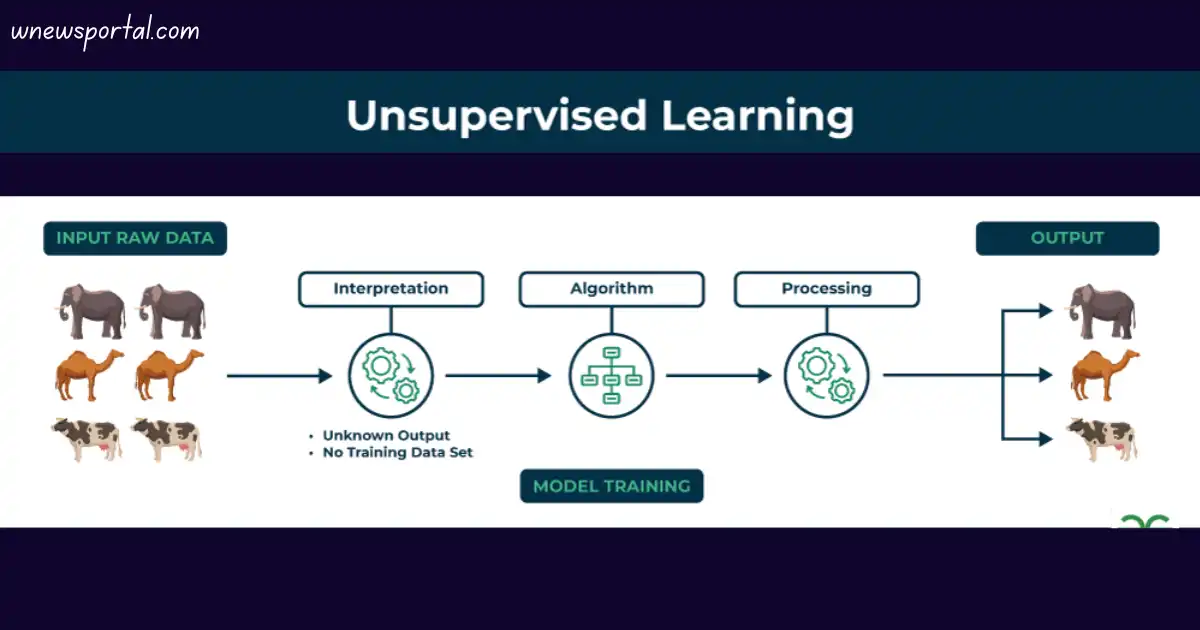
3. Semi-Supervised Learning
Semi-supervised learning combines elements of both supervised and unsupervised learning, utilizing both labeled and unlabeled data. This technique is particularly useful in situations where acquiring labeled data is costly, but a large amount of unlabeled data is available. By using even a small amount of labeled data, semi-supervised learning can significantly improve model accuracy without extensive labeling.
Algorithms for Semi-Supervised Learning
-
Generative Models:
Create new data points similar to the original data to improve model learning.
-
Self-Training:
Uses initial labeled data to train a model, which then labels additional data to expand the training dataset.
Applications
Semi-supervised learning is commonly used in areas with limited labeled data but significant potential for improvement with partial labeling:
-
Medical Imaging:
Many medical images lack labels, so semi-supervised models are valuable for recognizing patterns.
-
Natural Language Processing (NLP):
Unlabeled text data can be transformed into labeled data using semi-supervised learning, benefiting sentiment analysis and chatbot training.
Limitations
Fine-tuning is essential for balancing labeled and unlabeled data in semi-supervised learning. If the initial labeled data is sparse or not diverse enough, it may reduce the model’s performance or introduce biases.
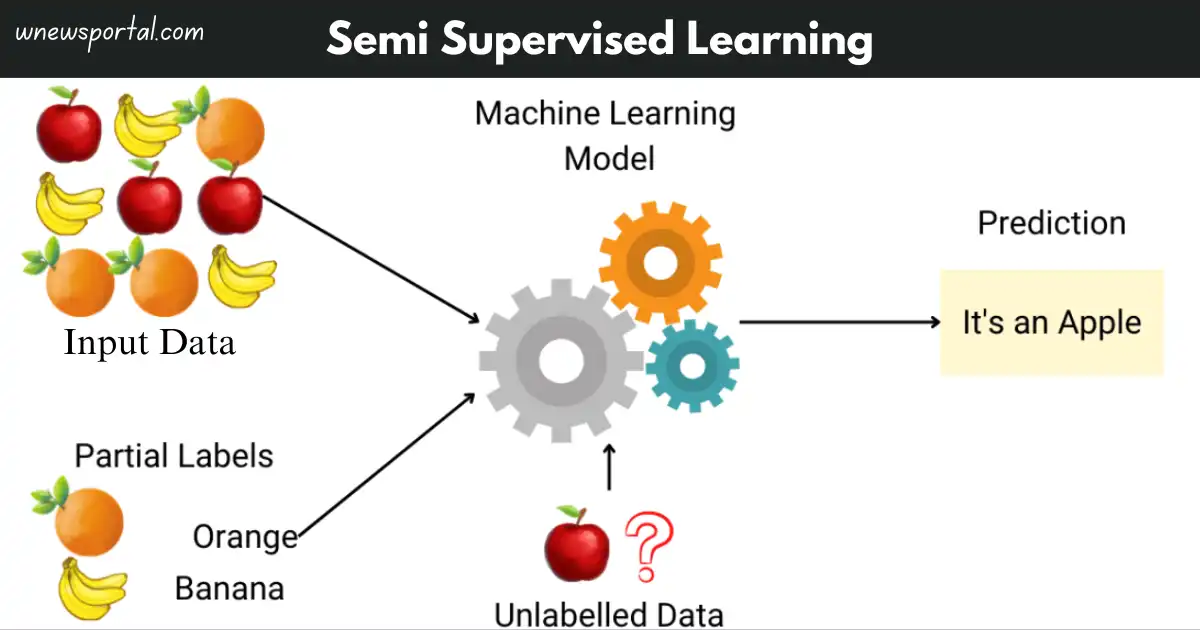
4. Reinforcement Learning (RL)
Reinforcement learning is a type of ML where an agent learns by interacting with an environment and receiving feedback based on its actions. The agent’s goal is to maximize cumulative rewards over time by learning the best strategies through trial and error. Reinforcement learning is unique in its approach to sequential decision-making, as each action impacts the future state and available choices.
Popular Techniques
-
Q-Learning:
A model-free approach that learns an action-value function to estimate the rewards of actions.
-
Deep Reinforcement Learning:
Combines deep neural networks with reinforcement learning, useful in complex environments like gaming.
Applications
RL is commonly used in areas that require continuous learning and adaptation:
-
Game Development:
AI opponents in games use RL to improve strategy and gameplay.
-
Robotics:
RL enables robots to perform complex tasks and navigate environments.
-
Autonomous Systems:
RL is fundamental in autonomous vehicles, which must make real-time decisions in dynamic settings.
Challenges
Reinforcement learning requires significant computational resources and time, and setting an effective reward structure can be challenging. Additionally, RL can inadvertently learn harmful behaviors if rewards are improperly defined.
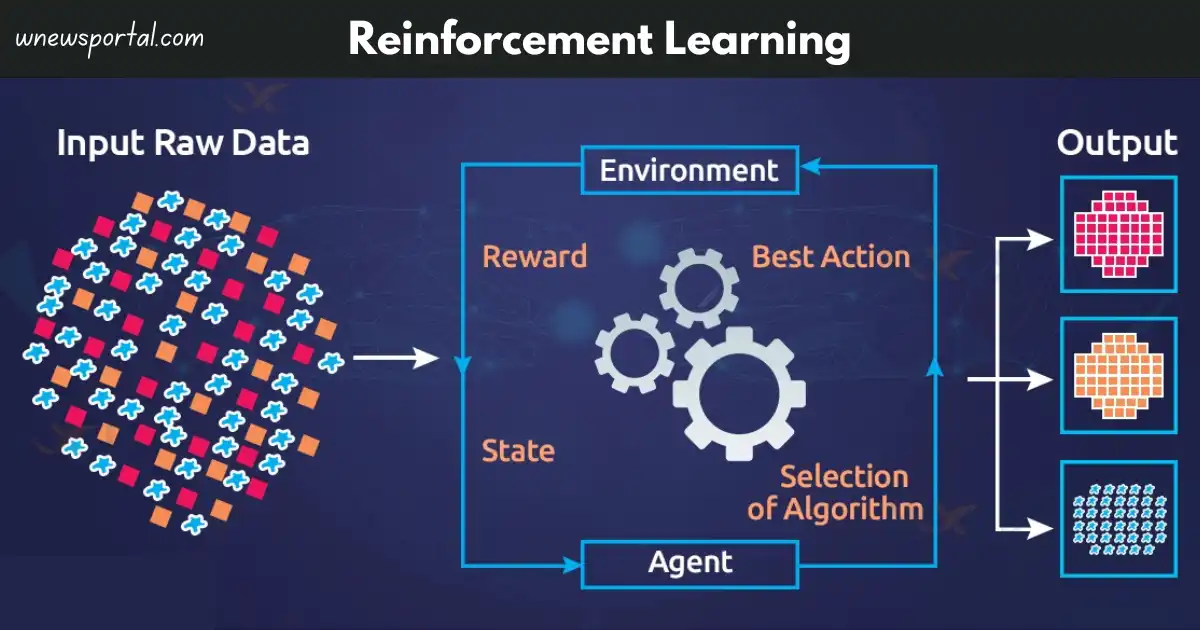
Detailed Comparison of 4 types of machine learning
A side-by-side comparison of 4 types of Machine Learning provides insight into their specific strengths and limitations:
| Type | Data Requirements | Common Applications | Challenges |
|---|---|---|---|
| Supervised Learning | Large labeled dataset | Stock prediction, medical diagnosis, image recognition | Labeling cost; risk of overfitting |
| Unsupervised Learning | Unlabeled data | Anomaly detection, customer segmentation, recommendations | Evaluation difficulty |
| Semi-Supervised Learning | Limited labeled + large unlabeled | Medical imaging, NLP | Balancing data; label quality essential |
| Reinforcement Learning | Interaction data | Gaming, robotics, autonomous vehicles | High computational needs |
Industry Applications-Kinds of Machine Learning
-
Healthcare:
Supervised learning for diagnosis; semi-supervised for medical imaging.
-
Finance:
Unsupervised learning for fraud detection; RL in algorithmic trading.
-
E-commerce:
Supervised learning for personalization; unsupervised learning for segmentation.
Future Trends of types of machine learning
Here are the future trends of these 4 types of Machine Learning:
Self-Supervised Learning:
A blend of supervised and unsupervised techniques that uses unlabeled data, advancing fields like NLP and computer vision.
Advanced Reinforcement Learning:
Applied to complex scenarios like autonomous systems and robotics.
As ML becomes more prevalent, ethical considerations are increasingly relevant. Bias in supervised learning data and unintended behavior in reinforcement learning highlight the need for fairness and regulation. Ensuring ML models are transparent, ethical, and compliant with regulations is crucial as they become more integrated into society.
You Might Be Interested In
- What is the role of AI in cyber security?
- What are solutions for cyber security?
- Deep Learning vs Neural Networks: What is the Difference?
- What is the future for robots?
- 11 Best Free AI Tools
Conclusion-What are the 4 types of machine learning?
The four types of ML (Supervised, Unsupervised, Semi-Supervised, and Reinforcement Learning) each serve distinct purposes and are essential for tackling a wide range of challenges. As machine learning continues to evolve, these foundational approaches will remain central to the development of AI-driven solutions. Understanding these types of machine learning enables innovators to harness machine learning’s full potential, shaping a future where AI is more responsive, ethical, and impactful.
FAQ’s about “What are the 4 types of machine learning?”
What are the 4 approaches to machine learning?
The four main approaches to machine learning are:
- Supervised Learning: This approach uses labeled data, where each input is paired with an output label. The model learns to map inputs to outputs, allowing for predictions on new data. Common algorithms include linear regression, decision trees, and neural networks. It’s often used in applications like image classification and fraud detection.
- Unsupervised Learning: In unsupervised learning, the model works with unlabeled data, identifying patterns and structures within the dataset. Techniques like clustering and association are used, with applications in customer segmentation and anomaly detection. Algorithms include k-means clustering, hierarchical clustering, and principal component analysis (PCA).
- Semi-Supervised Learning: This combines supervised and unsupervised learning, using a small amount of labeled data alongside a larger pool of unlabeled data. This approach is particularly useful when labeling data is expensive or time-consuming. Applications include medical image classification and natural language processing.
- Reinforcement Learning: This approach involves an agent that learns by interacting with an environment, receiving rewards or penalties based on its actions. Reinforcement learning is widely used in robotics, game development, and autonomous systems. Techniques include Q-learning and deep reinforcement learning, and key applications include real-time decision-making and dynamic environments.
Each of these approaches serves unique purposes and is chosen based on data availability, problem type, and required outcomes.
What are the 4 steps to make a machine learn?
The four essential steps to make a machine learn are:
- Data Collection: Gather relevant data that represents the problem you want the machine to learn. The quality and volume of data play a significant role in the model’s accuracy. For example, to build a model for image recognition, you would need a diverse set of labeled images.
- Data Preparation: Clean, process, and structure the data for optimal performance. This step includes handling missing values, normalizing or scaling features, and dividing data into training and testing sets. Quality preparation ensures the model receives consistent and accurate data.
- Model Training: Choose an appropriate algorithm and train the model using the training data. In this step, the model learns patterns from the data by adjusting its internal parameters. This process may include several iterations to optimize accuracy and minimize errors.
- Model Evaluation and Testing: Test the trained model on a separate set of data (usually the testing set) to evaluate its performance. Key metrics like accuracy, precision, recall, or F1 score help determine how well the model generalizes to new data. Based on these results, you may fine-tune or retrain the model to improve its accuracy.
These four steps—data collection, data preparation, model training, and evaluation—create a cycle of continuous improvement, ultimately making the model more effective at learning and making predictions.
What are the ML models?
- Linear Regression: Predicts continuous outcomes based on input features.
- Logistic Regression: Used for binary classification tasks.
- Decision Trees: Splits data into branches for classification or regression.
- Support Vector Machines (SVM): Classifies data by finding the optimal hyperplane.
- Naive Bayes: Classifies based on Bayes’ theorem and feature independence.
- k-Nearest Neighbors (k-NN): Classifies based on the closest training examples.
- Clustering Models: Groups data points into clusters based on similarity.
- Ensemble Models: Combines multiple models for improved accuracy.
- Neural Networks: Mimics brain structure for complex pattern recognition.
- Reinforcement Learning: Learns through feedback (rewards or penalties) from interactions with the environment.
These models are chosen based on the specific problem and data characteristics.
Which model is best in ML?
There is no single “best” machine learning model; the ideal choice depends on the specific problem, data characteristics, and use cases. Here are some commonly effective models:
- Random Forests: Great for mixed data types and reducing overfitting. Ideal for tasks like customer segmentation and fraud detection.
- Support Vector Machines (SVM): Effective for high-dimensional data and binary classification, making it suitable for applications in text classification and image recognition.
- Neural Networks: Best for complex tasks involving unstructured data, such as image and speech recognition, due to their ability to capture intricate patterns.
- Gradient Boosting Machines (GBM): Known for high predictive accuracy, they excel in risk assessment and customer churn prediction.
Choosing the right model often requires experimentation and tuning to determine which performs best for your needs.
What are the 4 types of machine learning in python?
The four types of machine learning in Python, corresponding to the various approaches used to train models, are:
- Supervised Learning: In this type, models are trained on labeled data, where the input and corresponding output are known. Common Python libraries for supervised learning include:
- Scikit-learn: Provides algorithms like Linear Regression, Decision Trees, and Support Vector Machines.
- TensorFlow and Keras: Used for building neural networks for classification and regression tasks.
- Unsupervised Learning: Models learn patterns from unlabeled data without any explicit outputs. Key Python libraries include:
- Scikit-learn: Offers algorithms like k-Means Clustering and Hierarchical Clustering.
- NumPy and Pandas: Used for data manipulation and analysis before applying unsupervised techniques.
- Semi-Supervised Learning: Combines labeled and unlabeled data for training. While less common, Python libraries that can be utilized include:
- Scikit-learn: Supports semi-supervised algorithms like Label Propagation.
- TensorFlow: Can be adapted for semi-supervised learning tasks.
- Reinforcement Learning: In this type, an agent learns by interacting with an environment and receiving feedback. Libraries in Python for reinforcement learning include:
- OpenAI Gym: A toolkit for developing and comparing reinforcement learning algorithms.
- Stable Baselines3: A set of reliable implementations of reinforcement learning algorithms.
Each type leverages different techniques and libraries to address specific problems and datasets.
